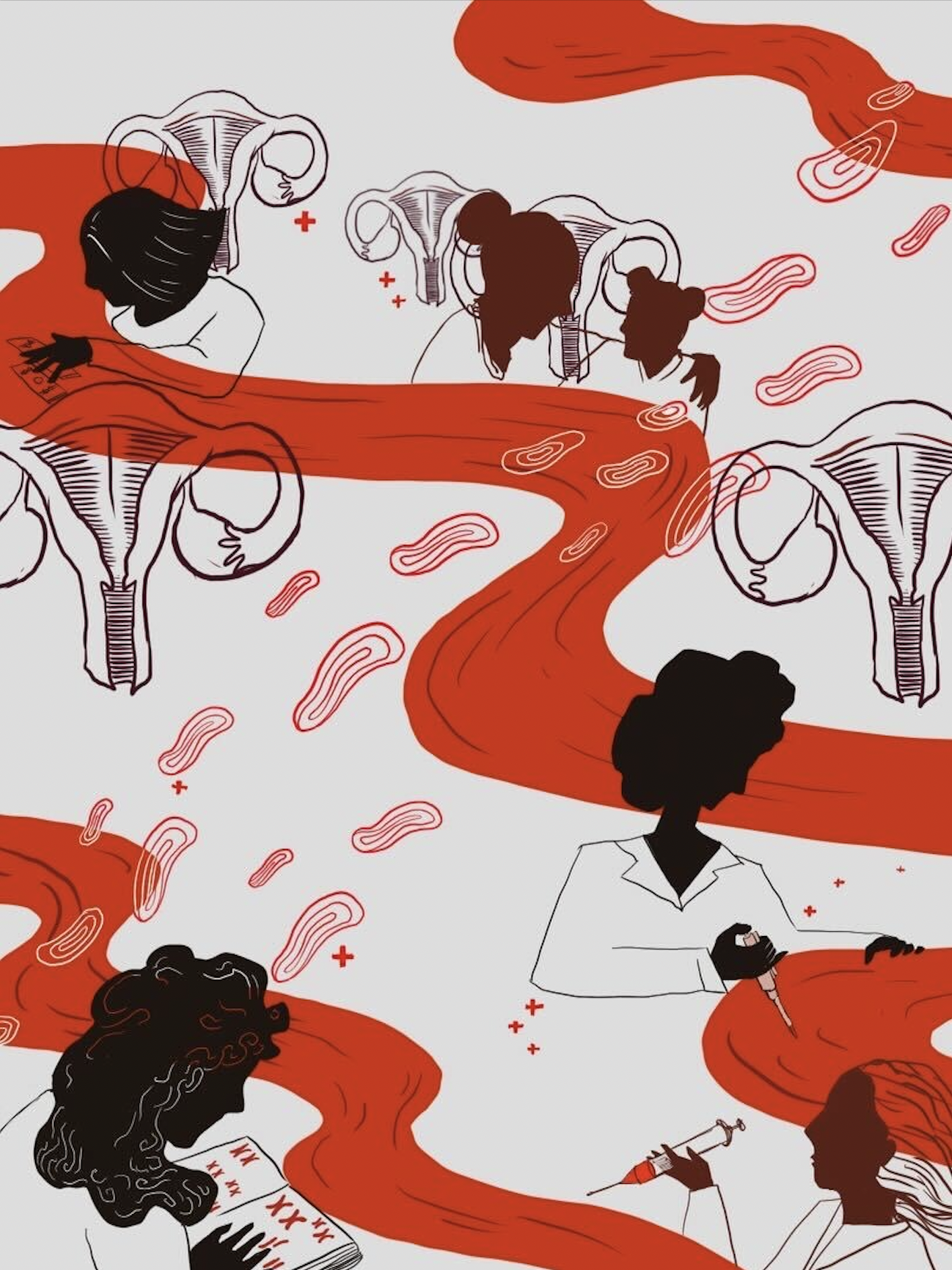
“Pain shared is pain lessened,” people have always
hypothesized — does the uterus yearn for such commisteration
as well?
The comfort of realizing you are not the only one on your
period—suffering from the dreadful cramps that consume every
minute, navigating the overwhelming mood swings, and
permeating discomfort—-temporarily ameliorates the
dreaded-painful monthly anniversary. As a college student
myself, I often overhear my dormmates, classmates, and
friends bond over having concurrent periods, laughing about
how their periods are syncing because they hang out too
often, leading me to wonder, does this marker of friendship
have any basis in science?
The menstrual cycle, which spans anywhere from 21-35 days, consists of four stages: menses, the follicular phase, ovulation, and the luteal phase. Ovulation, specifically, refers to when the eggs are released from the ovary; the follicular phase marks pre-ovulation and the luteal phase marks post ovulation [1]. The phase most familiar to us (that involves the physical bleeding) is menses, lasting around three to seven days [2]. Unfortunately, along with delivering a monthly dose of discomfort, this cycle often fails to remain consistent, as several factors alter both period lengths and its timing. Biologically, hormones and glands - specifically the hypothalamus, ovary, anterior pituitary, among others - play a prominent role in regulating periods. For example, the follicle stimulating hormone (FSH) is in charge of initiating follicle development and increasing the level of estrogen, whereas the luteinizing hormone contributes to egg maturation and assists with instigating ovulation [3]. Further, an individual’s DNA can contain certain mutations and abnormalities, usually found on the X-chromosome, so genetics also dictate factors such period timing and length [1].
The phenomenon of period syncing, which refers to when two people’s periods—or menses phases—occur at the same time, is often attributed to the two people living close to each other; Making it an especially hot topic for college students living together in dorms. Known as menstrual synchrony, or the McClintock Effect in the medical world, period syncing emerges from the notion that when two menstruating individuals live together. Their pheromones, which function similar to hormones but work outside the body, influence each other, leading to simultaneous period cycles [4]. The term “McClintock Effect'' arises from the known work directed by Dr. Marthak McClintock and Dr. Kathleen Stern. The theory originates from a study employing 135 college girls who lived together in a dorm and reported updates with their menstrual cycle three times during the academic year, examining whether their periods synced. The results of the study were in favor of the existence of period syncing. The subsequent release of findings from the McClintock study, in 1971, launched the concept of period syncing into popular culture [5].
However, several years later, in 2006, scientists released a paper dismantling the notion of period synchronization. In this study, scientists studied data collected from 186 Chinese women who lived in dorms together for a year, and who recorded their cycle dates for a little over a year. Once analyzing the intervals of the women’s cycles, the researchers ultimately determined that the women’s periods actually do not sync. They disproved the previously popular idea of period syncing by demonstrating that synchronization occurred by chance [6]. Further data from a study conducted by Oxford University, employing data from the Clue App, a period tracking app, only strengthened the rejection of the phenomena [4].
A mathematical approach by Dr. Strassman further suggests that periods do not sync. Dr. Strassman calculated the mathematical probability that periods overlap due to coincidence rather than due to the synchronization of pheromones, as proposed by McClintock and Stern. To break it down simply, because a period cycle on average is 28 days, the farthest time frame two women will be asynchronous is 14 days, meaning this is the farthest time frame where there will be
absolutely no overlap between periods. (On average the timeframe will be around seven days—fourteen is simply the extreme.) Because periods last five days on average, it is quite likely that periods will overlap, suggesting that overlapping periods is a result of coincidence - supported by mathematical probability - rather than biological period synchronization [7].
Although math and science seem to have undermined period syncing as a test of friendship, and or as proof of spending lots of time with particular friends, both the notion of period syncing and its attribution to mathematical coincidence require further research before making a strict decision. Further, the answers may lie outside of science in the emotion, psychological, or even spiritual realm. That being said, concurrent period cycles may have some relation, as there is much research to be done in the field of women’s health to possibly uncover information on period syncing. Further research on endocrinology, the menstrual cycle, and menstrual disorders may shed light on the notion of period syncing. But regardless of the mathematics, the comfort of bonding over simultaneous period cycles with your dorm-mates, and friends alike, persists nonetheless.
References
1. Hawkins, S. M., & Matzuk, M. M. (2008). The menstrual cycle: basic biology. Annals of the New York Academy of Sciences, 1135, 10–18. https://doi.org/10.1196/annals.1429.018
2. Normal menstruation (monthly period): Menstrual Cycle & Symptoms. Cleveland Clinic. (n.d.). Retrieved May 3, 2022, from https://my.clevelandclinic.org/health/articles/10132-normal-menstruation
3. UCSF Health. (2022, April 14). The menstrual cycle. ucsfhealth.org. Retrieved May 3, 2022, from https://www.ucsfhealth.org/education/the-menstrual-cycle
4. Watson, K. (2019, January 23). Is period syncing a real thing? why women's periods may sync up. Healthline. Retrieved May 3, 2022, from https://www.healthline.com/health/womens-health/period-syncing#origins-of-the-theory
5. McClintock, M. K. (1971, January 22). Menstrual Synchrony and Suppression. Cambridge, Massachusetts; Department of Psychology, Harvard University.
6. Yang, Z., & Schank, J. C. (2006). Women do not synchronize their menstrual cycles. Human nature (Hawthorne, N.Y.), 17(4), 433–447. https://doi.org/10.1007/s12110-006-1005-z
7. Beverly I. Strassmann, Menstrual synchrony pheromones: cause for doubt, Human Reproduction, Volume 14, Issue 3, March 1999, Pages 579–580, https://doi.org/10.1093/humrep/14.3.579
